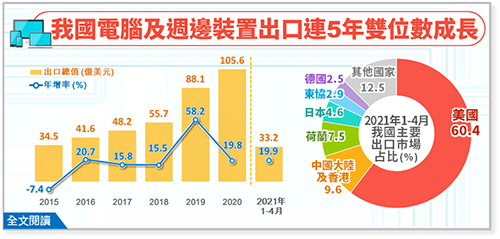The transfer of supply chain and the effect of housing economy have contributed to the double-digit growth of exports of computers and peripheral devices for five years.
The transfer of supply chain and the effect of housing economy have contributed to the double-digit growth of exports of computers and peripheral devices for five years.
China's exports of computers and peripheral devices have grown by double digits for five consecutive years, the Ministry of Economic Affairs said a few days ago. With the vigorous development of the information network and the rapid development of science and technology, China's exports of computers and peripheral devices have been rising at an annual rate of US $3.45 billion since 2015, with an annual increase of 15.2%. By 2019, affected by the trade dispute between the United States and China, some manufacturers' production lines have been moved back to China and the order effect has been injected into domestic production capacity, and the export value has jumped to US $8.81 billion, with an annual increase of 58.2%, of which servers have increased by 205.1%. The share rose to 39.0% and jumped to the first place. With the impact of the COVID-19 epidemic and the rise of long-distance business opportunities, the demand for computers and peripheral devices continued to increase. In 2020, exports totaled US $10.56 billion, an increase of 19.8%. With the continuation of the housing economy and emerging technology boom this year, coupled with the increased momentum of the global economic recovery, exports reached US $3.32 billion from January to April 2021, an annual increase of 19.9%.
As servers, graphics cards and other products are included in the third wave of tariff increases between the United States and China, leading to the transfer effect of the supply chain, according to the 2019 overseas production survey data, the production ratio of information and communication products in Chinese mainland decreased by 8.5 percentage points compared with 2017, while the ratio of production in China increased by 1.8 percent, and the ratio of information and communication products transferred to the United States and Europe also increased by more than 2 percentage points respectively. Under the effect of capacity return and turnaround, China's direct exports of computers and peripheral devices to the United States more than doubled annually in 2019, exceeding 50% for the first time, accounting for an increase of 19.7% over the previous year, while the proportion of exports to Chinese mainland and Hong Kong decreased by 3.7%. From January to April 2021, exports to the United States increased by 18.4%, accounting for 60%.
Looking at the import market of computers and peripheral devices in the United States in 2020, the largest source of import is Chinese mainland, with a market share of 51.1%. China has surpassed Thailand to become the third place since 2019, with a market share of 8.4% in 2020. Compared with 2017, except for Chinese mainland, the market share of other major import sources increased, of which China increased by 5.3%, with the most obvious growth rate, indicating that affected by the trade dispute between the United States and China, the source of imports of the United States has also changed with the transfer of the industrial chain.
The top six exporters of computers and peripheral devices in the world in 2020 are Chinese mainland, the Netherlands, Mexico, the United States, Hong Kong and Germany, but China has experienced double-digit growth in recent years with strong growth, indicating that the industry has actively returned to Taiwan to invest in recent years. Coupled with the injection of long-distance business opportunities, it will help to enhance China's position in the global supply chain.

- Prev

Chiayi County will apply for cash assistance for litchi victims caused by drought
The drought and water shortage in Chiayi County since the second half of last year has led to poor results of litchi in Chiayi County. Chiayi County-invited to gather Tainan District Agricultural improvement Farm, Agriculture and Food Administration and Public Office to form an investigation team to conduct on-the-spot investigation in Zhuqi Township and Fanlu Township in the main producing areas.
- Next

"Chiayi Aurora" cantaloupe returns strongly in spring
Chiayi fruit top boutique "Chiayi aurora" went on sale in spring! Chiayi County-twice last year, we cooperated with Dongsen Shopping Station to market "AURORAMELON" cantaloupe, which sold out on the first day, received high praise and made frequent calls.
Related
- A course of planting techniques and methods on how to grow carrots
- How to plant the latest tulips?
- Is it better to pick tea in the morning or in the afternoon? When is the best time for tea to be picked? what is the third or fifth tea?
- Launch Yuanxiao Happy combination Haocha + Tea Yuan healthy Taste
- Penghu Tourism "Fireworks 20 Parade with You"
- 2022 West Lake Happiness holds "Digital Revitalization Voucher" and draws iphone13 and laptop.
- Banqiao Fuzhou social houses are designed to change start-up combined with police elimination to create a safe and livable environment
- The convenient measure of "mechanical weeding" in Xinbei has been abused and the Agriculture Bureau has imposed heavy penalties on the illegal land consolidation.
- Changgeng University Joins Hands with Four Memory Factories to Rescue Memory Talent Shortage
- The list of Taiwan's top 100 MVP managers is listed by the Director-General of the Farmers' Association of Sanxia District.

